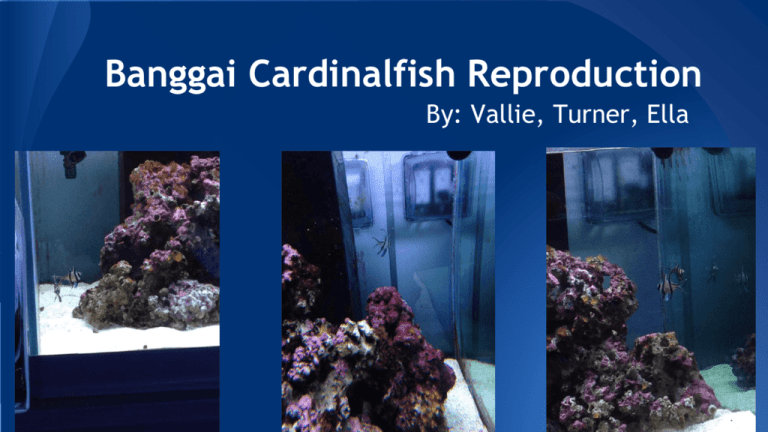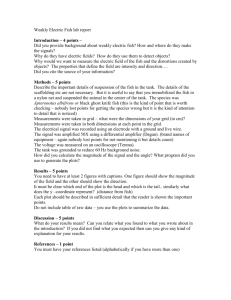Banggai
advertisement

Banggai Cardinalfish Reproduction By: Vallie, Turner, Ella Overview of Discussion 1. 2. 3. 4. 5. 6. 7. 8. 9. Intro Background Timeline Research Questions Hypothesis Material and Methods Review of Research Questions Tables/Graphs/Videos/Pictures Reflections and Conclusions Introduction ● Originally, our plan was to discover and implement the habitats that encourages the Banggai cardinalfish to breed ● However throughout the year, our goal simplified to observation and encouragement of reproductive behaviors ● We wanted to encourage the fish to mate and reproduce Background- General ● Kingdom: Animalia Phylum: Chordata Class: Actinopterygii Order: Perciformes Family: Apogonidae Scientific Name: Pterapogon Kauderni ● Location: Found in the Banggai Islands in the IndoPacific ● Behavior: Shy, hiding, easily startled ● Male v Female: males- more massive head and square jaw, females- more rounded with a less prominent jaw Background- Reproduction Behavior ● pairing with mate over spawning site and territorial ● Courtship occurs in afternoon, while spawning occurs at sunset ● Spawning signs: well-rounded belly in female, heightened activity between pair ● In captivity, spawning occurs once a month ● Male fertilizes eggs by swimming over them quivering his genital pores ● Mouthbrooders- 50 eggs, 21-30 days Timeline October 22nd- First day of observation of 6 fish in Observation Tank October 30th- 4 Banggais moved to Tank 3; 2 moved to Tank 9 along with the original fish November 5th- New Banggai in Tank 9 moved to Tank 5 after bullying November 11th- New Banggai in Tank 9 died; only original left December 10th- Fish D dies in Tank 3 January 21st- Fish C in Tank 3 develops tumor (parasites), taken out to die April 1st- Ovulation spotted Research Questions 1. Which type of shelter (natural or artificial) stimulates the most reproductive activity? 2. Will the fish noticeably pair off in the tanks? 3. How long will it take for the fish to form a pair? 4. If the fish do form pairs, does that mean they will necessarily breed? 5. Will the lack of shelter be a contributor to males eating eggs during incubation? Hypothesis ● After separating the Banggai cardinalfish into habitats with minimal shelter (PVC pipe) or natural shelter (live rock), the fish in the natural shelter of live rock will have the most pairs of fish and higher breeding rates because it emulates what the habitat in the ocean, thus decreasing the stress on the fish. Methods and Materials ● Original Plan: o Tank separated into natural (live rock) v. artificial ● What actually happened: o Adapted methods to simplify o Encouraged Banggai to breed using live rock Modified live rock structures o Moved fish to different tanks o Started feeding fish more often Fish A Fish C Fish B Fish D Videos of Behavior http://banggaireproduction.wiki.lovett.org/March+Videos#March%20Videos 2.Will the fish noticeably pair off in the tanks? ● Trends have shown that the fish physically spend time together in pairs; however, it has yet to be proven to be sexual ● Typically, the fish would be startled as we approached the tank and either scatter or pair together and hide, depending on their circumstances in the tank ● After quiet observation, the fish would usually pair together, maybe even chasing and following a bit ● However, this never developed into sexual pairing 3. How long will it take for the fish to form a pair? ● Our fish never paired sexually. ● They would be in the same location in the tank however they were not sexually paired 4. If the fish do form pairs, does that mean they will necessarily breed? ● The fish never formed pairs therefore we would not know how long it would take to breed. ● Research has shown from other scientists that it usually takes anywhere from one to several months after maturity for the Banggai to mate/form pairs. Unable to answer 1. Which type of shelter (natural or artificial) stimulates the most reproductive activity? 5. Will the lack of shelter be a contributor to males eating eggs during incubation? Reflections on Hypothesis After separating the Banggai cardinalfish into habitats with minimal shelter (PVC pipe) or natural shelter (live rock), the fish in the natural shelter of live rock will have the most pairs of fish and higher breeding rates because it emulates what the habitat in the ocean, thus decreasing the stress on the fish. Outside Sources “Once you obtain a male and a female, they may pair up almost instantly, but not guaranteed” “The hardest part is obtaining a good pair. First off, as many of you know, they are difficult to sex.” - Reef Central Website Challenges ● Determining sex ● Obtaining the right environment ● Keeping them alive ● Identification of fish Solutions/In the Future ● Tagging them for better identification ● Feeding them more often ● Confirming the sex of the fish Overall Concepts and Application ● Fish must be fully mature in order to mate ● Sex needs to be identified for sure (required: 1 male, 1 female) ● Environment with hiding places that are visible for observation Bibliography Works Cited Agliata, Jack. "Spawning the Banggai Cardinal." Tropical Fish Hobbyist Magazine May 2007: n. pag. Print. <__http://www.tfhmagazine.com/details/articles/spawning-the-banggai-cardinal.htm__> Allen, G.R, and T.J Donaldson. "Pterapogon Kauderni." The IUCN Red List of Threatened Species. N.p., 2007. Web. 2 Oct. 2014. <__http://www.iucnredlist.org/details/63572/0__>. "Banggai Cardinal Fish (Pterapogon Kauderni)." Fishlore. N.p., n.d. Web. 2 Oct. 2014. <__http://www.fishlore.com/profile-banggaicardinalfish.htm__>. "Captive Breeding of Banggai Cardinalfish." World Journal of Zoology 7.4 (2012): 273-78. Print. __http://www.google.com/url?sa=t&rct=j&q=&esrc=s&source=web&cd=6&ved=0CEEQFjAF&url=http%3A%2F%2Fwww.researchgate.net%2Fpublication%2F230875483_Captive_Breeding_of_Banggai_Ca rdinalfish_Pterapogon_kauderni_%28Koumans_1933%29_for_Exit_of_IUCN_Red_List%2Flinks%2F09e41505a0fb71bee8000000&ei=-jUsVI7HC8WzogS18YFw&usg=AFQjCNEiQSTJw4hQH3iTHxU-PAZRkUTDw&bvm=bv.76477589,d.cGU__ Kolm, Niclas. "Female Courtship in the Banggai Cardinalfish: Honest Signals of Egg Maturity and Reproductive Output?" Behavioral Ecology and Sociobiology 56.1 (2004): n. pag. JSTOR. Web. 2 Oct. 2014. <__http://www.jstor.org/discover/10.2307/25063415?searchUri=%2Faction%2FdoBasicSearch%3FQuery%3Dbanggai%2Bcardinalfish%26amp%3Bacc%3Don%26amp%3Bwc%3Don%26amp%3Bfc%3Do ff&resultItemClick=true&Search=yes&searchText=banggai&searchText=cardinalfish&uid=2134&uid=2129&uid=3739616&uid=375514101&uid=2&uid=70&uid=3&uid=375514091&uid=3739256&uid=60&sid =21104811764183__>. Kolm, Niclas, and Anders Berglund. "Wild Populations of a Reef Fish Suffer from the 'Nondestructive' Aquarium Trade Fishery." Conservation Biology 17.3 (2003): 910-14. JSTOR. Web. 2 Oct. 2014. <__http://www.jstor.org/discover/10.2307/3095250?searchUri=%2Faction%2FdoBasicSearch%3FQuery%3Dbanggai%2Bcardinalfish%26amp%3Bacc%3Don%26amp%3Bwc%3Don%26amp%3Bfc%3Doff &resultItemClick=true&Search=yes&searchText=banggai&searchText=cardinalfish&searchText=banggai&searchText=cardinalfish&uid=2134&uid=2129&uid=3739616&uid=375514101&uid=2&uid=70&uid= 3&uid=375514091&uid=3739256&uid=60&sid=21104811764183__>. Moorhead, Jonathan A., and Chaoshu Zeng. "Development of Captive Breeding Techniques for Marine Ornamental Fish: A Review." Reviews in Fisheries Science 18.4 (2010): 315-43. Advanced Placement Source. Web. 2 Oct. 2014. <__http://eds.b.ebscohost.com/eds/detail/detail?vid=2&sid=cdf8062f-93f0-4efa-865557f673f29beb%40sessionmgr198&hid=117&bdata=JnNpdGU9ZWRzLWxpdmU%3d#db=aqh&AN=54330519__>. Ulrich, Albert. "Breeding the Banggai Cardinalfish." Saltwater Aquarium Blog. N.p., 10 June 2012. Web. 2 Oct. 2014. <__http://saltwateraquariumblog.com/breeding-the-banggai-cardinalfish__>. Wittenrich, Matthew L. The Complete Illustrated Breeder's Guide to Marine Aquarium Fishes. Neptune City, NJ: T.F.H. Publications, 2007. Print.




